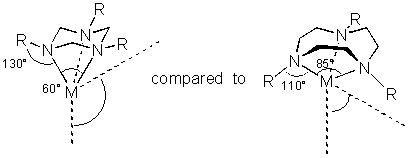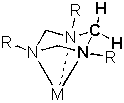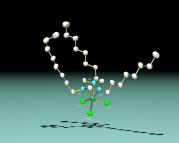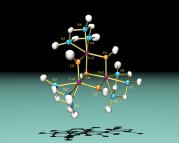One topic just is not enough ...
We like to play around with several aspects of coordination chemistry:
We have been developing the co-ordination chemistry of triazacyclohexanes to the whole transition metal series
from the lanthanides [1] to copper and zinc over several years and successfully applied complexes of chromium
as catalysts for the polymerisation [2] and trimerisation [3] of olefins and more recently lanthanide
complexes as Lewis acid catalysts.
The advantages and unusual properties of these ligands are:
- Triazacyclohexanes are very cheap and highly variable as they can be easily prepared within a few
hours from primary amines and formaldehyde and they are known for many N-substituents for over 100 years.
However, the co-ordination chemistry of this potentially large pool of ligands was largely unexplored until
we started to investigate their co-ordination chemistry a few years ago. We and more recently other groups
have been able to demonstrate that trizacyclohexane complexes of most transition metals can be prepared.

- The proximity of the three nitrogen donor atoms in triazacyclohexanes enforces very
acute N-metal-N angles of 60° in facial co-ordination. In addition, a very large metal-N-R
angle of typically 130° is enforced which dramatically reduces any steric effect of the N-substituents.
This makes this ligand one of the sterically least demanding tri-dentate ligand and allows reactions with large
substrates or the stabilisation of large metal fragments such as transition metal clusters.

- The nitrogen lone pairs cannot be directed towards the metal due to the rigid nature
of the triazacyclohexane ring. This causes a severely "bent" bonding situation to the metal and thus
a weakend N-metal interaction. Therefore, the bonding energy of a triazacyclohexane to the metal is much
smaller than that of three unstrained N-metal bonds. As a result most complexes studied so far can be
hydrolysed by water although some "inert" complexes (e.g. those of Cr(III)) may decompose only very slowly.
As another consequence, triazacyclohexanes can also serve as bi-dentate or even mono-dentate ligands with
not much difference in total bonding energy.

- The triazacyclohexane frame in tri-dentate co-ordination is very rigid.
The crystal structures of about 30 complexes have nearly super-imposable positions for the N, C and H (endo and exo) of the ring.
Therefore, the relative position of these atoms can be described by a single variable: the N-metal bond length.

- In the system [(triazacyclohexane)Ni(NCR)3]2+, we were able to quantitatively understand the shifts and line-broadening
of the NMR spectra of these paramagnetic complexes using the information of the relative position of the two different ring hydrogen atoms.
These nuclei could then be used as internal reference to obtain structural information for the remaining NMR-observable nuclei.
As these positions can easily be replaced by deuterium (from deutero-formaldehyde), the NMR signals can be obtained even in highly paramagnetic
complexes (e.g. Cr(III)) by using 2H-NMR (whose line broadening is up to 1/42 smaller than for 1H !).
So far, we have successfully used these advantages of triazacyclohexanes in the catalytic polymerisation and trimerisation
of olefins with MAO-activated triazacyclohexane-CrCl3 complexes. We were able to show that this system is the first good
homogeneous model system for the very important Phillips catalyst in ethylene polymerisation.[1,2] We found very high activity
probably due in part to the small steric demand of the ligand - in deed, we were able to selectively trimerise the more bulky
a-olefins for the first time with our system. Selectivity, activity and isomer distribution of the trimers could be easily varied
by the variation of the N-substituents. Our mechanistic model suggests that h3 to
h1 ring slippage of the triazacyclohexane might be
important for the trimerisation activity. We have also been able to observe the catalyst by 2H-NMR of complexes with ring-deuterated ligands.
- New sandwich complexes of praseodynium containing triazacyclohexane lingands,
R. D. Köhn, Z. Pan, G. Kociok-Köhn, M. F. Mahon,
J. Chem. Soc., Dalton Trans. (2002) 2344-2347.
- Triazacyclohexane complexes of chromium as highly active homogeneous model systems for the Phillips catalyst,
R. D. Köhn, M. Haufe, S. Mihan, D. Lilge,
Chem. Commun. (2000) 1927-1928.
- Selective Trimerization of a-Olefins with Triazacyclohexane Complexes of Chromium as Catalysts,
R. D. Köhn, M. Haufe, G. Kociok-Köhn, S. Grimm, P. Wasserscheid, W. Keim,
Angew. Chem., 112 (2000) 4519-4521; Angew. Chem., Int. Ed. Engl, 39 (2000) 4337-4339.
The chromium based Phillips catalyst has been known since the early 1950s and even today nearly half of all
HDPE is produced by this catalyst.
However, compared to other polymerisation catalysts very little is known about its molecular
nature and the mechanism. Consequently, many coordination compounds that show even the slightest polymerisation activity have been
published as model systems despite their apparent failure to reproduce the typical characteristics of the Phillips catalysts such
as their temperature dependence of the produced molecular weights, the unusual end groups, ability to co-polymerise a-olefins
or the selectivity for trimerisation.
 Structure of an highly active pre-catalyst for the ethylene polymerisation
Structure of an highly active pre-catalyst for the ethylene polymerisation
We have found that long chain substituted complexes [(R3TAC)CrCl3]
can be activated with methylaluminoxane (MAO) to give highly active catalysts that can reproduce all those important features
and may allow to study the mechanism of the polymerisation with the Phillips catalyst for the first time by a true model system.
The easy variability of the ligand system may now allow the tailoring of the catalyst to produce specific polymer properties
that were not accessible with the heterogeneous Phillips systems before. Additionally, ligand variations can lead to catalysts
for the selective trimerisation of ethylene and higher a-olefins.
Triazacycloalkane complexes in general are good model systems for many biological copper enzymes that are
involved in the transport and activation of oxygen.
We have developed the coordination chemistry of analogous R3TAC complexes. Especially the structural
characterisation of many Cu(I) and Cu(II) complexes helped to understand the differences in their chemistry to other complexes.
The small ligand allows the coordination of two Me3TAC to CuCl2 and leads to a system
that can catalytically activated oxygen via Cu(I).
- Syntheses and Structures of 13-Substituted 1,5,9-Triazatricyclo-[7.3.1.05,13] tridecanes and their Copper(II) Chloride Complexes,
R. D. Köhn, G. Seifert, G. Kociok-Köhn,
Chem. Ber. 129 (1996) 21-24.
Transition metal clusters with oxygen or sulphur bridges play an important role in many enzymes.
Many have complete or partial cubane-like core structures [M4X4] embedded in proteins as in ferredoxins
or in the photo-system II. Model complexes try to replace the protein environment by simple ligands.
We have found that triazacyclohexanes are especially suited to function as tridentate capping ligands.
The rigid nature of the R3TAC bonding environment allows the analysis of paramagnetic complexes by NMR.
 Structure of a partial Co3O4 cubane cluster supported by R3TAC
Structure of a partial Co3O4 cubane cluster supported by R3TAC
- Synthesis and Characterization of the Cobalt(II) Methoxide Core {Co3(OMe)4}2+.
R. D. Köhn, M. Haufe, G. Kociok-Köhn, A. C. Filippou,
Inorg. Chem. 36 (1997) 6064-6069.




 Structure of an highly active pre-catalyst for the ethylene polymerisation
Structure of an highly active pre-catalyst for the ethylene polymerisation
 Structure of a partial Co3O4 cubane cluster supported by R3TAC
Structure of a partial Co3O4 cubane cluster supported by R3TAC